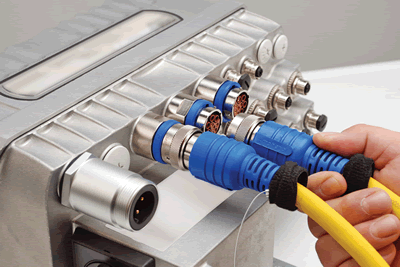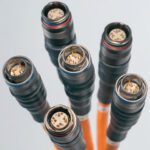Cable Connectivity for Variable Frequency Drives
The VFD cable is often an afterthought in the exhaustive research and consultation process to choose an advanced variable frequency drive. Here, Wayne Spence of Amphenol Sine explains why it is critical to the overall system.
 The phone rings; your chest begins to pound, and the receiving manager’s voice confirms it’s the moment you’ve long awaited: “VFDs are here!”
The phone rings; your chest begins to pound, and the receiving manager’s voice confirms it’s the moment you’ve long awaited: “VFDs are here!”
Instantly you’re on your feet, leaving behind the blueprints and timelines that now cover what once was a visible desktop. You replay the months of analysis, various considerations, and the weighing of the pros and cons that preceded the arrival of the many carefully packaged variable frequency drives (VFDs).
You realize that the intricacies of controlled starting current, adjustable operating speed and torque, controlled stopping, reverse operation, and overall energy consumption would be futile without one key element. Your exhaustive research and consultation with various manufacturers of today’s most technologically advanced VFDs and premium-efficient motors has revealed that the substantial capital investment will not be realized without the correct VFD cable. Unfortunately, it’s often viewed as an afterthought, but the cable represents an increasingly critical component to a successful implementation.
To prevent your best-laid plans from being disrupted by reflective wave, common mode noise, and corona discharge, let’s briefly examine high-performance VFD cables and, more specifically, the connection points within the overall system.
With the sophistication of modern VFD systems, precise cable installation is critical for optimum performance. The overall construction among the leading manufacturers is highly advanced, demonstrating an acute awareness of core component technology such as conductor insulation type, thickness, shielding, grounding criterion with the lowest possible capacitance level, and cable jacket types to address an array of applications. The primary struggle to ensure functionality at the equipment’s highest potential in nearly all instances relies on proper installation of the VFD cable for maximum performance capability.
Cable installation guidelines that vividly illustrate either fixed or continuous motion considerations are readily available from both the VFD and cable manufacturer. After successfully accomplishing appropriate cable routing, only a few critical steps remain, such as proper conductor prep and placement of the conductors, with the utmost attention afforded to the PE ground and available equipment grounding provisions.
This is the pivotal point where unwarranted removal of the cable jacket, braided shield, excessive unraveling of a twisted pair, or more typical imperfections such as nicked or even eliminated drain wires can occur. These system flaws require days to purge and, if left unchecked, are often costly to replace, which brings to mind the old adage: Measure twice and cut once.
Other options include complete molded cable solutions; once limited to larger OEM installations, they now are increasingly penetrating mid-sized projects as well. The basis for these recent advancements is characterized by terms such as “turnkey” cable assemblies. These products combine advanced VFD cable with newly available molded connector technology, along with improved shielding capability. The benefit is multiple conductor pairs for increased signal availability, which can be utilized for requirements such as brake control or thermal monitoring in addition to the primary power and ground conductors which also comprise the cable.
The cable assembly benefits occur as a result of automated testing throughout the build process. The cable shielding and termination complexities are now mitigated by a systematic and controlled process. When combined with molded connector ends, electrical functionality and subsequent performance in the field is ensured.
The connector’s engineered design, in conjunction with the cable, not only achieves the performance characteristics necessary for today’s advanced VFD, but also comply with various codes such as NFPA 79 and UL 2237, thus eliminating concerns over agency approvals at sign-off.
To accomplish the plug-and-play concept, placement of the connector receptacle is provided by the VFD manufacturer before shipment. When these units arrive on-site, the modern connectivity enables technicians to quickly accommodate a diverse range of installation requirements and topologies in a highly reliable manner.
In short, consult the VFD manufacturer for its time-tested recommendations as well as new cable interconnect practices in use today. You’ll be glad you did.
Author Wayne Spence is director, Amphenol Sine Systems.






